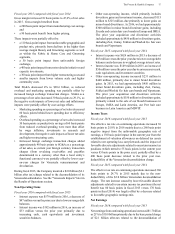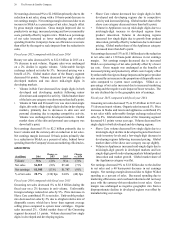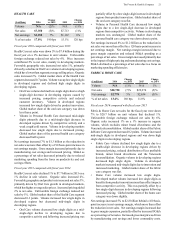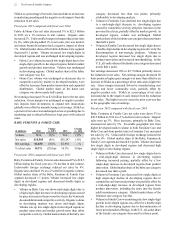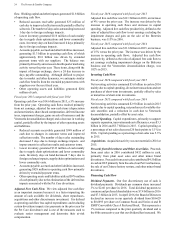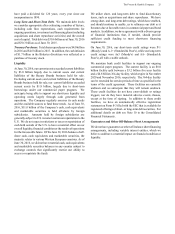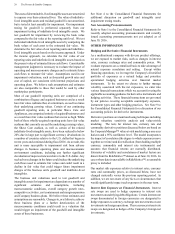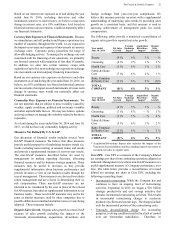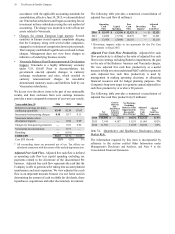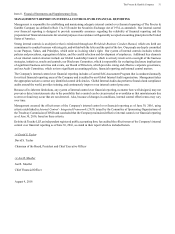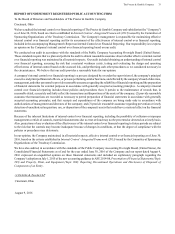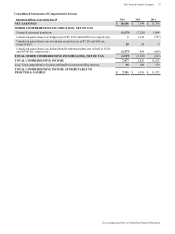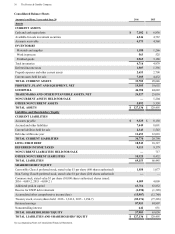Proctor and Gamble 2016 Annual Report Download - page 40
Download and view the complete annual report
Please find page 40 of the 2016 Proctor and Gamble annual report below. You can navigate through the pages in the report by either clicking on the pages listed below, or by using the keyword search tool below to find specific information within the annual report.
26 The Procter & Gamble Company
Contractual Commitments
The following table provides information on the amount and payable date of our contractual commitments as of June 30, 2016.
Amounts in millions Total Less Than 1 Year 1-3 Years 3-5 Years After 5 Years
RECORDED LIABILITIES
Total debt $ 30,221 $ 11,635 $ 3,660 $ 3,467 $ 11,459
Capital leases 45 16 21 5 3
Uncertain tax positions
(1)
247 247———
OTHER
Interest payments relating to long-term debt 6,439 684 1,249 979 3,527
Operating leases
(2)
1,563 237 464 360 502
Minimum pension funding
(3)
640 215 425 — —
Purchase obligations
(4)
1,794 881 391 234 288
TOTAL CONTRACTUAL COMMITMENTS $ 40,949 $ 13,915 $ 6,210 $ 5,045 $ 15,779
(1)
As of June 30, 2016, the Company's Consolidated Balance Sheet reflects a liability for uncertain tax positions of $1.2 billion, including
$343 million of interest and penalties. Due to the high degree of uncertainty regarding the timing of future cash outflows of liabilities for
uncertain tax positions beyond one year, a reasonable estimate of the period of cash settlement beyond twelve months from the balance
sheet date of June 30, 2016, cannot be made.
(2)
Operating lease obligations are shown net of guaranteed sublease income.
(3)
Represents future pension payments to comply with local funding requirements. These future pension payments assume the Company
continues to meet its future statutory funding requirements. Considering the current economic environment in which the Company operates,
the Company believes its cash flows are adequate to meet the future statutory funding requirements. The projected payments beyond fiscal
year 2019 are not currently determinable.
(4)
Primarily reflects future contractual payments under various take-or-pay arrangements entered into as part of the normal course of business.
Commitments made under take-or-pay obligations represent future purchases in line with expected usage to obtain favorable pricing. This
includes service contracts for information technology, human resources management and facilities management activities that have been
outsourced. While the amounts listed represent contractual obligations, we do not believe it is likely that the full contractual amount would
be paid if the underlying contracts were canceled prior to maturity. In such cases, we generally are able to negotiate new contracts or
cancellation penalties, resulting in a reduced payment. The amounts do not include other contractual purchase obligations that are not take-
or-pay arrangements. Such contractual purchase obligations are primarily purchase orders at fair value that are part of normal operations
and are reflected in historical operating cash flow trends. We do not believe such purchase obligations will adversely affect our liquidity
position.
SIGNIFICANT ACCOUNTING POLICIES AND
ESTIMATES
In preparing our financial statements in accordance with U.S.
GAAP, there are certain accounting policies that may require
a choice between acceptable accounting methods or may
require substantial judgment or estimation in their application.
These include income taxes, certain employee benefits and
goodwill and intangible assets. We believe these accounting
policies, and others set forth in Note 1 to the Consolidated
Financial Statements, should be reviewed as they are integral
to understanding the results of operations and financial
condition of the Company.
The Company has discussed the selection of significant
accounting policies and the effect of estimates with the Audit
Committee of the Company's Board of Directors.
Income Taxes
Our annual tax rate is determined based on our income,
statutory tax rates and the tax impacts of items treated
differently for tax purposes than for financial reporting
purposes. Also inherent in determining our annual tax rate are
judgments and assumptions regarding the recoverability of
certain deferred tax balances, primarily net operating loss and
other carryforwards, and our ability to uphold certain tax
positions.
Realization of net operating losses and other carryforwards is
dependent upon generating sufficient taxable income in the
appropriate jurisdiction prior to the expiration of the
carryforward periods, which involves business plans, planning
opportunities and expectations about future outcomes.
Although realization is not assured, management believes it is
more likely than not that our deferred tax assets, net of valuation
allowances, will be realized.
We operate in multiple jurisdictions with complex tax policy
and regulatory environments. In certain of these jurisdictions,
we may take tax positions that management believes are
supportable, but are potentially subject to successful challenge
by the applicable taxing authority. These interpretational
differences with the respective governmental taxing authorities
can be impacted by the local economic and fiscal environment.
Our operating principles are that our tax structure is based on
our business operating model, such that profits are earned in
line with the business substance and functions of the various
legal entities. However, we may have income tax exposure
related to the determination of the appropriate transfer prices



